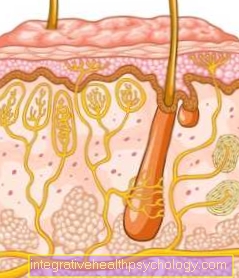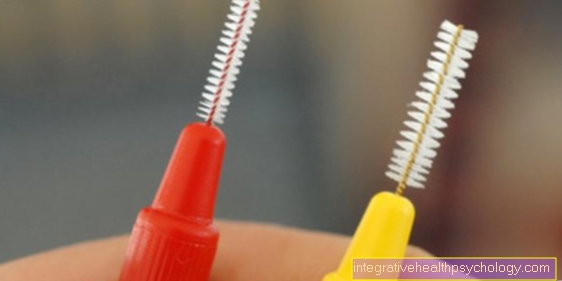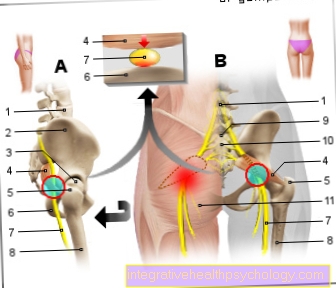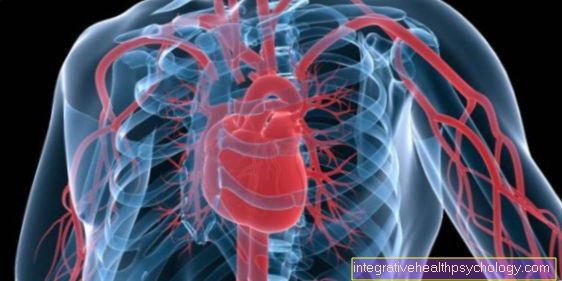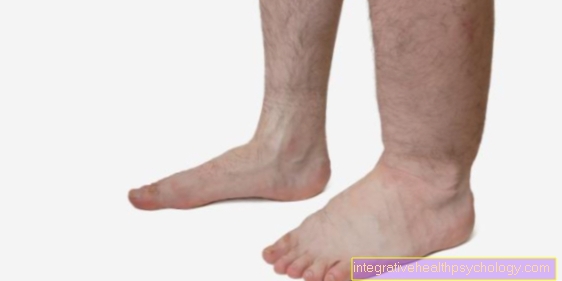Uterine fibroids
Synonyms in a broader sense
Uterine myomatosus, intramural myoma, subserous myoma, submucosal myoma
English: myoma
definition
Under a Myoma one understands a benign tumor that starts from the muscle layer of the uterus.
frequency
It is estimated that around every third woman over the age of 30 has a myoma. They represent the most common benign uterine tumors there- less than 0.5% of the fibroids become malignant.
root cause
A definitive cause for the tumor formation could not yet be determined. However, it has been proven that the muscle cells are supported by the female sex hormone estrogen be stimulated and therefore only in childbearing age, i.e. between puberty and Menopause (also note our topic Menopause), appear again.
Forms of development
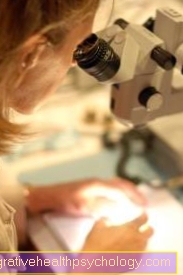
The structure of the uterus (p. Anatomy uterus) is divided into three layers: The inner cavity is made up of mucous membrane (Mucosa), while the uterus is lined from the outside by a connective tissue skin (Serosa) is covered. Between these two layers lies the muscle layer in which a Myoma can occur. According to this nomenclature, the direction of spread of a myoma is divided into three forms:
- The so-called intramural (lat.: intra- within, mura- the wall) growth, the tumor spreads only within the thick muscle layer. This type of growth is the most common.
- The subserous (lat.: sub-under, serosa-the connective tissue skin) Myoma is characterized by a growth direction outward, in the direction of the covering, connective tissue skin. They run the risk of pinching off neighboring structures such as the ureters or blood vessels that border the uterus.
- The submucosal (lat.: sub -under, mucosa-the mucous membrane) growth is accompanied by a spread of the myoma inwards, towards the cavity of the uterus. This form of growth is rather rare, but becomes noticeable particularly early due to bleeding abnormalities.
Furthermore, all types of myoma can change over time. This includes e.g. the cavitation (cystic remodeling) or induration (Calcification). Particularly in the case of submucosal myomas, there is a risk of ascending infections from the uterine cavity due to their growth in the direction of the uterine cavity Scabbard. A subserous one is called parasitic Myomathat in the Peritoneum grows in and is then supplied with blood by this.
A so-called stalk formation is possible with all forms of growth. Here the actual tumor is only attached to its place of origin by a kind of connective tissue stalk. There is always the risk that a rotation around its own axis will pinch off supplying vessels in the stalk and cause cell death within the myoma.
The so-called Uterus myomatosus the uterus is interspersed with numerous tumors, which usually leads to massive symptoms.
Symptoms
Bleeding abnormalities occur in a large proportion of women affected. Long (longer than 7 days) persistent and heavy bleeding, even outside of normal menstruation, occurs particularly when the myoma spreads towards the mucous membrane. This often leads to anemia. Violent abdominal cramps can also occur.
If the size of the fibroid presses on the ureter, intestine or spine, problems with urination, constipation and back pain can occur.
Particularly in the case of submucosal fibroids, implantation problems and displacement phenomena lead to increased miscarriages and premature births as well as malformations of the fetus (see also topics premature birth, miscarriage).
The connection between fibroids and corpus luteum insufficiency and ovulation disorders, which can lead to infertility (see also the topic of infertility), has not yet been clarified.
During pregnancy one regularly observes a reversible (reversible) increase in the size of myomas, which, in addition to the increased stimulation by the female sex hormone, is mainly caused by water retention.
After birth, more problems with placenta and bleeding were observed in women with a myoma.
After the menopause, the fibroids are not expected to disappear. However, due to their hormone dependency, the tumors shrink and the symptoms disappear.
Also read our article: Postmenopausal bleeding - these are the causes
Pain
A myoma is a benign tumor that is caused by the Muscles of the uterus goes out and often does not cause any symptoms. However, problems and symptoms can also arise with the fibroid. For one, it can be through the fibroid too Spotting come the womb (uterus) is irritated by the fibroid and such Mucous membrane can come off. It can also be with a fibroid Pain come. Myoma pain varies greatly from woman to woman, but most of the time it is mild and occasional Abdominal painthat are difficult to locate. In other women, however, the pain caused by the fibroid is much stronger and can even become cramp-like. At this point at the latest, a suitable therapy should be considered and the patient should consider having the fibroid removed. However, some patients describe the pain caused by the fibroid more like a Feeling of pressureas if a slightly painful and uncomfortable foreign body was in the Abdomen sits. Especially with Sexual intercourse The women then complain of increasing pain and a feeling of pressure. That the pain of the fibroid gets worse during intercourse is quite understandable, as it is caused by the penetration of the penis in the uterus to further irritation of the uterine lining, which in turn occurs Pain fibers activates the pain in the brain hand off.
In some cases, the pain caused by the fibroid may even project not only onto the abdomen but also into the area of the abdomen bladder. Here it can namely through the strong Size expansion the fibroid cause the bladder to become irritated again and again. This can lead to a proliferation Urge to urinate (micturition) and in addition, the irritation of the bladder can lead to recurring pain. In rare cases, the myoma can expand to such an extent that even the rectum is moved backwards by the fibroid of the uterus, which in turn determines Nerve fibers can irritate. This can then too Back pain or stomach pain lead, sometimes also kick Pelvic pain and or Leg pain on. However, this pain is not very typical of a fibroid and occurs rather seldom also. Typical pains for fibroids include Abdominal pain and the pain during and after Sexual intercourseBoth pains can also occur in many other gynecological diseases and are not fibroid-specific pain.
pregnancy

It is not uncommon for a fibroid to be discovered during pregnancy, since fibroids are benign (benign) Tumors of the Uterine muscles which very often cause no symptoms at all.
As it is used extensively during pregnancy Preventive medical check-up for pregnant women comes, it may be that during one of these examinations it is noticed that the woman has fibroids, which have not caused her any symptoms.
In addition, women increasingly "female hormones" how Estrogens produced.
This leads to the fact that the growth of the fibroids is stimulated and thus the fibroid can get bigger during pregnancy.
However, it is only in the rarest of cases that previously unremarkable fibroids cause major problems for the woman during pregnancy. However, with particularly large fibroids, the child's position in the uterus (uterus) is affected.
On the one hand, this can lead to the child in a "wrong" position like the Breech position, or that there is an early onset of the Labor pains comes. In addition, pregnancy is a great burden for the mother.
Pregnancy plus a fibroid can cause bladder and Intestines the mother are not only constricted by the child, but are also displaced by the myoma. On the one hand, this can convey the permanent feeling that the patient needs to go to the toilet (increased need to urinate), on the other hand it can happen that the patient Constipation (Constipations) gets. In addition, fibroids can take up a lot of space in the uterus and it does Egg cell at the beginning of pregnancy can make it impossible to implant (Nidation).
Therefore, due to the fibroid, it cannot lead to pregnancy or only to it Ectopic pregnancies come. Thus, although in rather rare cases, a fibroid can cause a infertility which is why it should then be removed to allow the egg cell to implant in the uterus.
But even when treating myoma, one should pay attention to whether a pregnancy is still desired or not, since with some myoma treatments a subsequent pregnancy is no longer possible. All in all, however, it is rare for fibroids to cause major problems for the patient before or during pregnancy.
However, it is important to know that a fibroid can also lead to the failure of a pregnancy, which is why you should contact your gynecologist if you wish to become pregnant (Gynecologist) should be examined extensively in order to remove any larger fibroids before pregnancy so that they cannot cause any problems during pregnancy.
diagnosis
The gynecological palpation examination often provides the first stops, but this is usually confirmed with a cell examination by smear, which should be normal in the case of a myoma.
An ultrasound examination through the vagina or abdomen (vaginal or abdominal ultrasound) is also suitable for establishing a diagnosis, since larger myomas can already be seen here.
If no findings are available yet, the option of a uterine or laparoscopy remains (Hystero- or. laparoscopy).
Read more on the topic: Endoscopy
Note: uterine cancer
The bleeding disorders that occur frequently should be clarified in any case, because there is one behind them, especially after the menopause Uterine cancer (Endometrial cancer).
OP of a fibroid

A Myoma should always be approached therapeutically when it causes physical symptoms or is already too infertility led.
If there is no desire to have children (see also Unfulfilled desire to have children) more or are the symptoms of Myoma not too pronounced, drug therapy can be used. The aim here is to use a Hormone therapy To inhibit the growth of the fibroid and, if possible, to reduce its size. Disadvantages of hormonal treatment are, on the one hand, the menopausal symptoms it triggers (e.g. hot flashes, osteoporosis, Mood swings and Vaginal dryness) and the fact that the fibroid continues to grow after the medication is stopped. The use of Painkillers (See also Medication) mostly mainly symptom-oriented and should make the symptoms more bearable.
Surgical treatment (Myoma OP) is always advisable when a malicious event cannot be ruled out or dangerous complications arise. An existing desire to have children in the case of infertility is an indication for a myoma operation. The type of operation depends on the extent of the myoma and family planning. If you only have single fibroids and you want to have children, the uterus be spared as possible. Depending on the location of the fibroid, this can be achieved with an operation using a laparoscopy or incision or with a uterine mirror. The tumors can be viewed through a viewing device (endoscope) via the navel resp. Scabbard is introduced, first assessed and then gently removed.
If there is no desire to have children and the expansion of the fibroids is pronounced, the entire uterus should be in one Myoma OP to be removed (hysterectomy). Depending on the size of the fibroids, this can be done by incision in the abdomen or through the vagina.
Another therapy option is the ligature of the two uterine arteries (Fibroid embolization). Catheters are pushed into the uterine arteries on both sides via small incisions in the groin, and these vessels are closed with polyvinyl alcohol particles. The desired result, achieved by cutting off the blood supply, is a reduction in the size of the fibroids, but this is often only of short duration.
Myoma removal
A fibroid is a harmless (benign) Growth of the uterine muscles (Uterine muscles). As long as the fibroids are symptom-free, they are seldom discovered and do not necessarily have to be treated. However, if symptoms such as bleeding occur, the patient can consider having the fibroid removed. There are various ways of doing this. To have a fibroid removed, the patient usually has to go to a hospital. The fibroid can then be removed here, for example by scraping. Here, the affected area of the uterus is removed under general anesthesia. Since only the fibroid is removed without removing any other surrounding tissue, it is called enucliation. Here it is usually possible to remove the uterus (uterus) so far intact and so little damage that the woman still has the opportunity to bear children even after the operation. In addition to enucleation, there are also other options for removing the fibroid. Embolization is still a fairly new method. Here, the artery that supplies the myoma becomes blocked or obliterated. As a result, the myoma cannot be supplied with nutrients and oxygen and thus regresses on its own. Embolization is not a direct removal of the myoma, but rather an indirect one. However, since it is often not possible to estimate how much surrounding tissue perishes with this method, embolization is often avoided in women who wish to have children. In drastic cases and in women who do not wish to have children, the fibroid can also be removed by removing the entire uterus from the patient. However, this is the ultima ratio, i.e. the last choice, but can be used in patients with a risk of malignant (malignant) Degeneration or persistent complaints from the fibroids should be considered.




